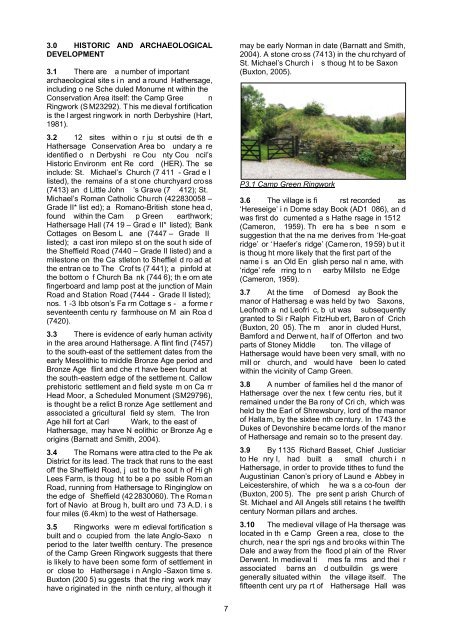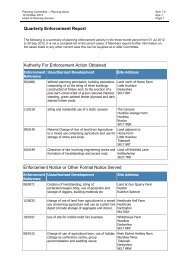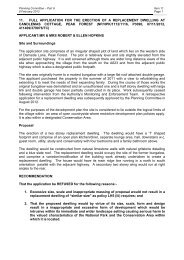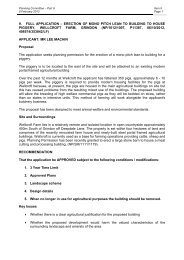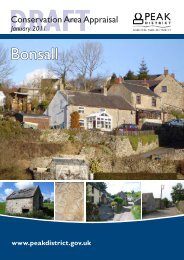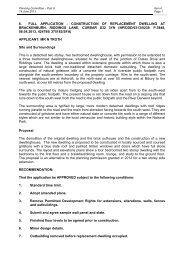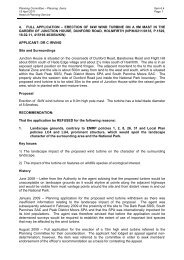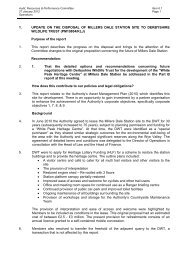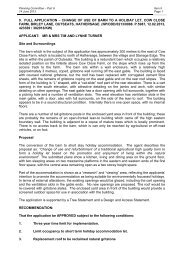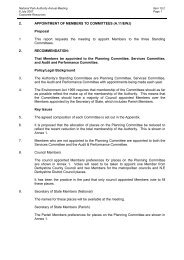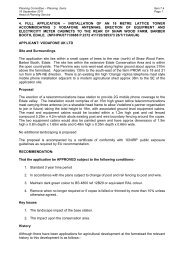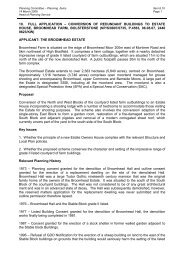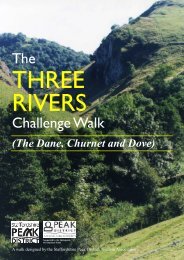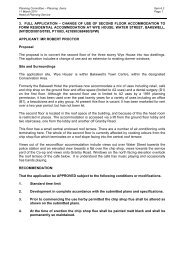Appendix - Peak District National Park Authority
Appendix - Peak District National Park Authority
Appendix - Peak District National Park Authority
Create successful ePaper yourself
Turn your PDF publications into a flip-book with our unique Google optimized e-Paper software.
3.0 HISTORIC AND ARCHAEOLOGICALDEVELOPMENT3.1 There are a number of importantarchaeological site s i n and a round Hathersage,including o ne Sche duled Monume nt within theConservation Area itself: the Camp Gree nRingwork (S M23292). T his me dieval f ortificationis the l argest ringwork in north Derbyshire (Hart,1981).3.2 12 sites within o r ju st outsi de th eHathersage Conservation Area bo undary a reidentified o n Derbyshi re Cou nty Cou ncil’sHistoric Environm ent Re cord (HER). The seinclude: St. Michael’s Church (7 411 - Grad e Ilisted), the remains of a st one churchyard cross(7413) an d Little John ’s Grave (7 412); St.Michael’s Roman Catholic Church (422830058 –Grade II* list ed); a Romano-British stone hea d,found within the Cam p Green earthwork;Hathersage Hall (74 19 – Grad e II* listed); BankCottages on Besom L ane (7447 – Grade IIlisted); a cast iron milepo st on the sout h side ofthe Sheffield Road (7440 – Grade II listed) and amilestone on the Ca stleton to Sheffiel d ro ad atthe entran ce to The Crof ts (7 441); a pinfold atthe bottom o f Church Ba nk (744 6); th e orn atefingerboard and lamp post at the junction of MainRoad and Station Road (7444 - Grade II listed);nos. 1 -3 Ibb otson’s Fa rm Cottage s - a forme rseventeenth centu ry farmhouse on M ain Roa d(7420).3.3 There is evidence of early human activityin the area around Hathersage. A flint find (7457)to the south-east of the settlement dates from theearly Mesolithic to middle Bronze Age period andBronze Age flint and che rt have been found atthe south-eastern edge of the settleme nt. Callowprehistoric settlement an d field syste m on Ca rrHead Moor, a Scheduled Monument (SM29796),is thought be a relict B ronze Age settlement andassociated a gricultural field sy stem. The IronAge hill fort at Carl Wark, to the east ofHathersage, may have N eolithic or Bronze Ag eorigins (Barnatt and Smith, 2004).3.4 The Romans were attra cted to the Pe ak<strong>District</strong> for its lead. The track that runs to the eastoff the Sheffield Road, j ust to the sout h of Hi ghLees Farm, is thoug ht to be a po ssible Rom anRoad, running from Hathersage to Ringinglow onthe edge of Sheffield (42 2830060). Th e Roma nfort of Navio at Broug h, built aro und 73 A.D. i sfour miles (6.4km) to the west of Hathersage.3.5 Ringworks were m edieval fortification sbuilt and o ccupied from the late Anglo-Saxo nperiod to the later twelfth century. The presenceof the Camp Green Ringwork suggests that thereis likely to have been some form of settlement inor close to Hathersage i n Anglo -Saxon time s.Buxton (200 5) su ggests that the ring work mayhave o riginated in the ninth ce ntury, al though itmay be early Norman in date (Barnatt and Smith,2004). A stone cro ss (7413) in the chu rchyard ofSt. Michael’s Church i s thoug ht to be Saxon(Buxton, 2005).P3.1 Camp Green Ringwork3.6 The village is fi rst recorded as‘Hereseige’ i n Dome sday Book (AD1 086), an dwas first do cumented a s Hathe rsage in 1512(Cameron, 1959). Th ere ha s bee n som esuggestion that the na me derives from ‘He-goatridge’ or ‘ Haefer’s ridge’ (Came ron, 19 59) b ut itis thoug ht more likely that the first part of thename i s an Old En glish perso nal n ame, with‘ridge’ refe rring to n earby Millsto ne Edge(Cameron, 1959).3.7 At the time of Domesd ay Book themanor of Hathersag e was held by two Saxons,Leofnoth a nd Leofri c, b ut was subsequentlygranted to Si r Ralph FitzHub ert, Baro n of Crich(Buxton, 20 05). The m anor in cluded Hurst,Bamford a nd Derwe nt, ha lf of Offerton and twoparts of Stoney Middle ton. The village ofHathersage would have been very small, with nomill or church, and would have been lo catedwithin the vicinity of Camp Green.3.8 A number of families hel d the manor ofHathersage over the nex t few centu ries, but itremained under the Ba rony of Cri ch, which washeld by the Earl of Shrewsbury, lord of the manorof Hallam, by the sixtee nth century. In 1743 theDukes of Devonshire b ecame lords of the mano rof Hathersage and remain so to the present day.3.9 By 1135 Richard Basset, Chief Justiciarto He nry I, had built a small church i nHathersage, in order to provide tithes to fund theAugustinian Canon’s pri ory of Laund e Abbey inLeicestershire, of which he wa s a co-foun der(Buxton, 200 5). The pre sent p arish Church ofSt. Michael and All Angels still retains t he twelfthcentury Norman pillars and arches.3.10 The medieval village of Ha thersage waslocated in th e Camp Green a rea, close to thechurch, nea r the spri ngs a nd bro oks wi thin TheDale and away from the flood pl ain of the RiverDerwent. In medieval ti mes fa rms and thei rassociated barns an d outbuildin gs weregenerally situated within the village itself. Thefifteenth cent ury pa rt of Hathersage Hall was7


